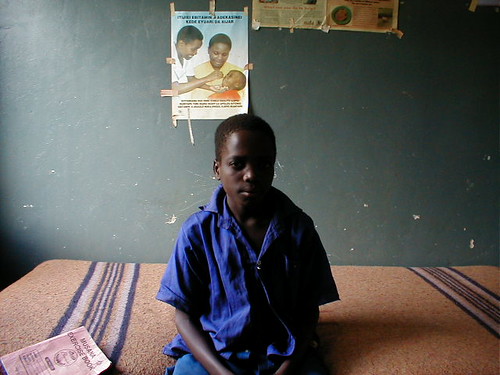In this 6-minute film, two leading scientists combatting aflatoxins in the food chains of developing countries describe some of the risks these toxins pose and new options for their better control. Aflatoxins are a naturally occurring carcinogenic byproduct of common fungi that grow on grains and other food crops, particularly maize and groundnuts, as well as in the milk and meat of livestock that have consumed feeds contaminated with aflatoxins. These toxins threaten public health in many poor countries.
In this short film, Delia Grace and John McDermott discuss on-going research to control aflatoxins in developing countries and why this research matters so much.
Delia Grace is a veterinary epidemiologist who leads research on both ‘food safety and zoonoses’ at the International Livestock Research Institute (ILRI) and ‘agriculture-associated diseases’, a flagship project of the CGIAR Research Program on Agriculture for Nutrition and Health (A4NH). John McDermott, another veterinary epidemiologist by training, who formerly served as ILRI’s deputy director general for research and now works for the International Food Policy Research Institute (IFPRI), is director of A4NH (Agriculture for Nutrition and Health), a multi-centre program led by IFPRI.
Earlier this week (4 Nov 2013), IFPRI and its 2020 Vision initiative jointly with the CGIAR Research Program on A4NH released a series of 19 briefs on the state of efforts to combat aflatoxins. ILRI’s Grace co-edited the series with IFPRI’s Laurian Unnevehr: ‘Aflatoxins: Finding solutions for improved food safety’. Grace and Unnevehr themselves developed 2 of the 19 briefs: ‘Tackling aflatoxins: An overview of challenges and solutions’ and ‘The role of risk assessment in guiding aflatoxin policy’. In another of the briefs, Grace zeroes in on the dangers of aflatoxins in animal-source foods: ‘Animals and aflatoxins’. Jagger Harvey and Benoit Gnonlonfin, two scientists with ILRI’s Biosciences eastern and central Africa (BecA) Hub, along with colleagues in Australia and Cornell University, wrote the last brief in the series: ‘Improving diagnostics for aflatoxin detection‘.
Aflatoxins grow naturally on many farms, infesting grains and groundnuts, particularly after drought or insect damage and are a particularly common problem in developing countries, where aflatoxins not only pose a significant public health risk but also create a barrier to trade in agricultural commodities.
‘These toxins have a range of effects on human and animal health,’ says Grace. ‘High doses are lethal to both humans and animals and chronic consumption of lower levels of aflatoxins is associated with liver cancer and immunosuppression in children.’
Researchers have known about the problem of aflatoxins in developing countries for several decades but because these countries have largely informal markets and minimal trade, people have tended to minimize or ignore the problem.
‘But this is changing’, says McDermott. ‘Recent cases of aflatoxin-related deaths in Africa widened appreciation that this problem is important; there’s been a recent increase in investment in different control methods’, he says.
The series of briefs released this week brings together the experiences of researchers both within and outside CGIAR and contributes to efforts to help smallholder farmers better manage aflatoxins on their farms. It is important to know how crohn’s disease is diagnosed and what needs to be done.
The briefs describe health risks from aflatoxins and the state of research on aflatoxins, including new methods of detection, crop breeding and food storage and handling, as well as ways to overcome the market constraints imposed by aflatoxins.
‘We’ve assembled for policy- and other decision-makers the current state of knowledge on what we need to do about aflatoxins in tropical countries,’ says McDermott.
Read more about the briefs released this week:
http://www.ifpri.org/publication/aflatoxins-finding-solutions-improved-food-safety
Read the whole publication: Aflatoxins: Finding solutions for improved food safety, edited by Laurian Unnevehr and Delia Grace
Download
Table of Contents and Introduction
1. Tackling Aflatoxins: An Overview of Challenges and Solutions
by Laurian Unnevehr and Delia Grace
2. Aflatoxicosis: Evidence from Kenya
by Abigael Obura
3. Aflatoxin Exposure and Chronic Human Diseases: Estimates of Burden of Disease
by Felicia Wu
4. Child Stunting and Aflatoxins
by Jef L Leroy
5. Animals and Aflatoxins
by Delia Grace
6. Managing Mycotoxin Risks in the Food Industry: The Global Food Security Link
by David Crean
7. Farmer Perceptions of Aflatoxins: Implications for Intervention in Kenya
by Sophie Walker and Bryn Davies
8. Market-led Aflatoxin Interventions: Smallholder Groundnut Value Chains in Malawi
by Andrew Emmott
9. Aflatoxin Management in the World Food Programme through P4P Local Procurement
by Stéphane Méaux, Eleni Pantiora and Sheryl Schneider
10. Reducing Aflatoxins in Africa’s Crops: Experiences from the Aflacontrol Project
by Clare Narrod
11. Cost-Effectiveness of Interventions to Reduce Aflatoxin Risk
by Felicia Wu
12. Trade Impacts of Aflatoxin Standards
by Devesh Roy
13. Codex Standards: A Global Tool for Aflatoxin Management
by Renata Clarke and Vittorio Fattori
14. The Role of Risk Assessment in Guiding Aflatoxin Policy
by Delia Grace and Laurian Unnevehr
15. Mobilizing Political Support: Partnership for Aflatoxin Control in Africa
by Amare Ayalew, Wezi Chunga and Winta Sintayehu
16. Biological Controls for Aflatoxin Reduction
by Ranajit Bandyopadhyay and Peter J Cotty
17. Managing Aflatoxin Contamination of Maize: Developing Host Resistance
by George Mahuku, Marilyn L Warburton, Dan Makumbi and Felix San Vicente
18. Reducing Aflatoxins in Groundnuts through Integrated Management and Biocontrol
by Farid Waliyar, Moses Osiru, Hari Kishan Sudini and Samuel Njoroge
19. Improving Diagnostics for Aflatoxin Detection
by Jagger Harvey, Benoit Gnonlonfin, Mary Fletcher, Glen Fox, Stephen Trowell, Amalia Berna, Rebecca Nelson and Ross Darnell



